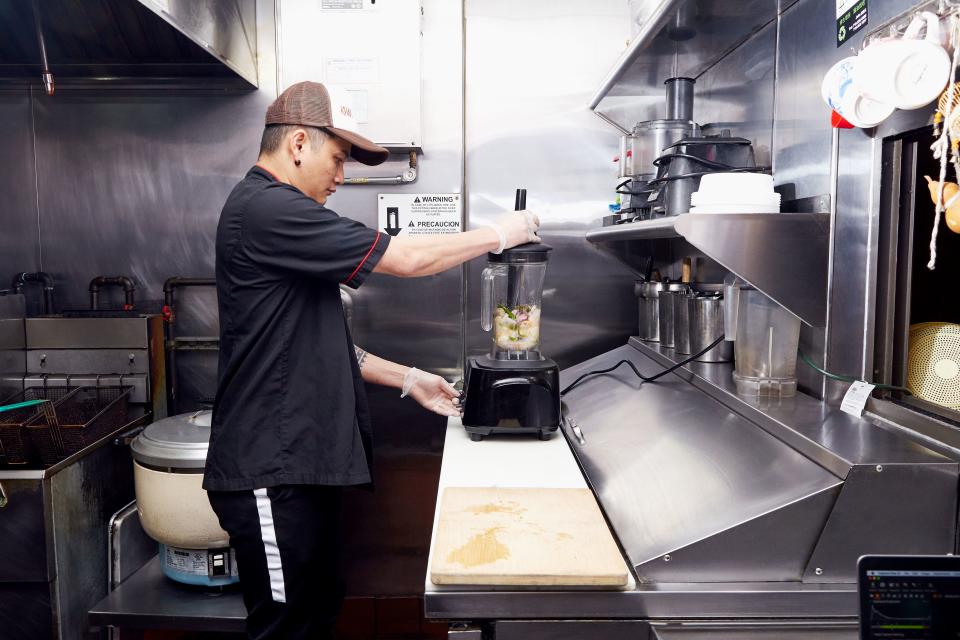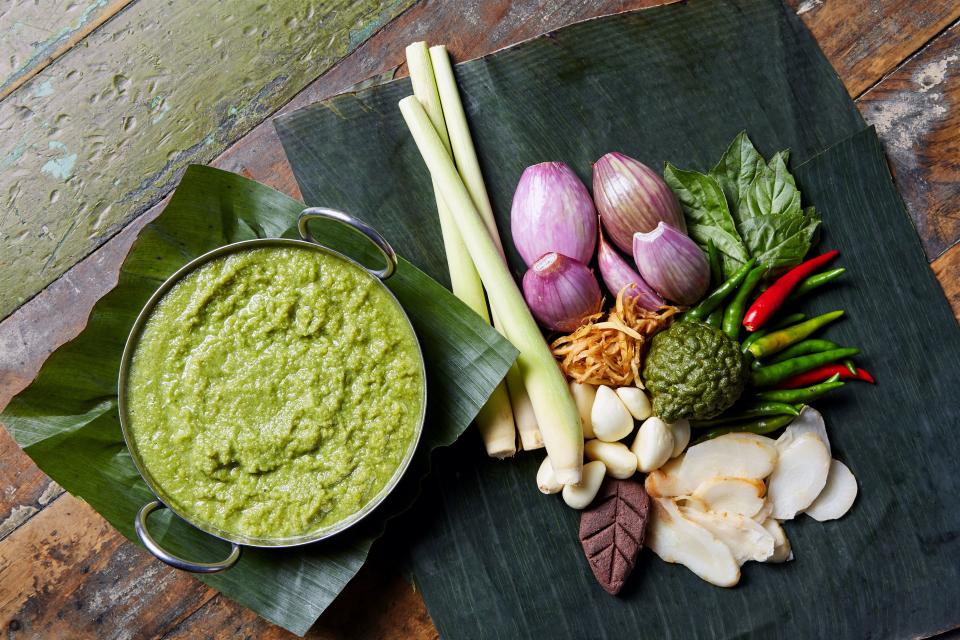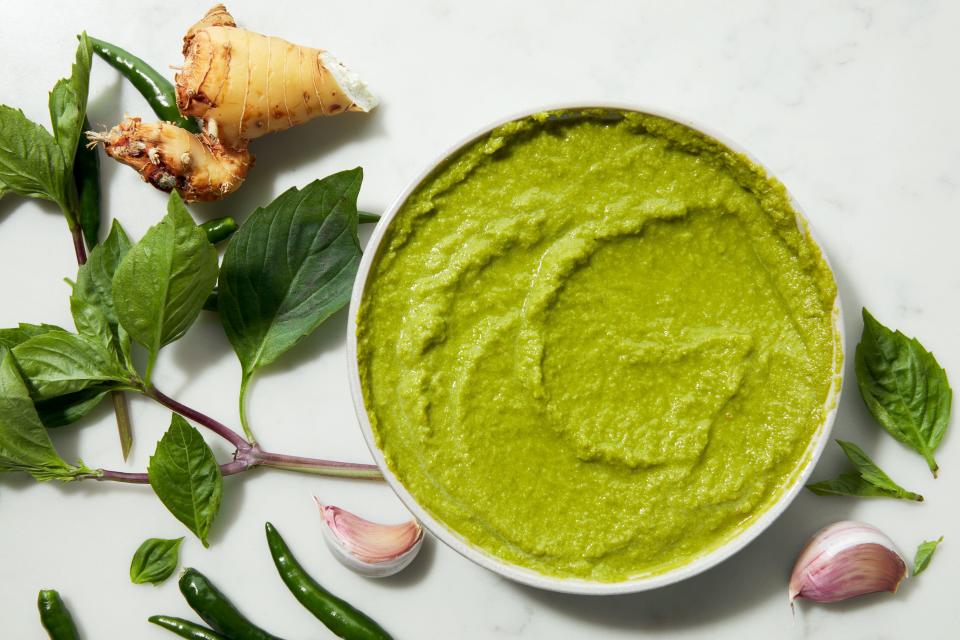How to Make Thai Green Curry Paste from Scratch
If you live within walking distance of New York’s unofficial Thai Town in Elmhurst, Queens, you have lots of choices for places to get your curry fix. Khao Kang is mine.
The moment you open the door to Khao Kang, you know you’re in the company of people who take their food seriously. Aromas of fish sauce, coconut, and prickly herbs hit you in concussive bursts. As you step closer to a steam table containing a dozen-odd dishes to ladle over rice, the aromas marry and snap into focus: a twang of fermented bamboo in brothy, sour curry; the meaty whiff of kua kling, a dry curry of ground pork in a thick coat of spices, comforting as sloppy joe and hotter than a subway station in August.
When I first asked Sopon Kosalanan, the owner of Khao Kang, for a lesson in how to make curry paste at home, I had no idea the kitchen made its own from scratch. Very few American Thai restaurants do—it’s simply too costly and labor intensive to meet customer demand, and besides, expecting housemade curry paste at your average Thai restaurant is like demanding that an Italian joint forego canned tomatoes for fresh ones year-round. But if your top priority is vivid flavor, the kind of aromatic intensity that makes great Thai cooking so memorable, DIY is the way to go.

Khao Kang - INSET
“You’re going to smell the herbs, the chile, the lemongrass, the galangal,” Kosalanan says. “If you get it from a can, I don’t feel like it’s green curry. It doesn’t have the same aromas. It’s just something that you cook in coconut milk.” Making curry paste from scratch also gives you the freedom to adjust the heat level to your own taste. While some of Khao Kang’s kaengs—the Thai word for curry—are knock-you-over spicy, others exhibit only the slightest kick.
When Kosalanan arrived in the United States 17 years ago from the town of Chanthaburi, finding curry paste essentials like galangal and makrut limes was a tall order. These days, he says, it’s much easier. He and his mother, Tongtad Jarernnan, who is also the restaurant’s chef, use a network of local Thai markets, but they also mail-order produce from specialty growers in Florida to gather the supplies for Khao Kang’s popular green curry. Civilians like us can find most of the fresh produce to make Thai curry paste online at websites like Import Food.
Once you’ve assembled your curry components, making the actual paste is no more difficult than whipping up a batch of hummus or pesto.

Khao Kang Ingredients - HERO
Photo by Joseph De Leo, Food Styling by Sopon KosalananYour Green Curry Ingredients Checklist
Some of the ingredients for Khao Kang’s kaeng khiao wan (green curry, sometimes spelled gaeng khiaw wan) can be found in the average grocery store. Others may be harder to find. Here’s what to look for, and what they add to the curry.
Thai bird chiles: These tiny green peppers, no longer than your pinkie finger, bring a blast of heat and green color to the paste. Remove the stems but leave the pods whole; seeds are part of the package.
Thai basil: Back home, Kosalanan’s family uses other Thai herbs to lend spicy green aroma and color to their curry, but here, Thai basil is a worthy substitute. It’s a distinct plant from the common Italian basil: less sweet and with a subtle licorice bite, so I wouldn’t recommend swapping one for the other. If you can’t find Thai basil, shiso or perilla leaves would be your next best bet—hardly a common substitution, but thematically on point.
Lemongrass: Many Chinese and Southeast Asian markets carry fresh lemongrass. When pounded into curry paste, the fibrous stalks release their full citrus-balm flavor.
Galangal: A rhizome that looks a lot like ginger, but with a thinner skin and tougher fibers. Its taste is hard to describe: notes of citrus and pine with a distinct cooling character in opposition to ginger’s heat. It keeps well if tightly wrapped in the refrigerator, and is an integral part of several Thai soups.
Ka chai: Another hard-to-find rhizome that has an earthiness similar to fresh turmeric root. Even now, Kosalanan says, getting fresh ka chai in the U.S. is nearly impossible, so he buys it jarred. You can also reconstitute dried ka chai by soaking it in hot water for 20 minutes, or you can take a page from another school of Thai green curry by substituting fresh turmeric.

KhaoKang - INSET
Photo by Joseph De Leo, Food Styling by Sopon KosalananMakrut lime zest: A bumpy-skinned citrus you may know by another name. The aromatic leaves are a popular Thai flavoring, but for this curry paste, you specifically want the zest for its fresh, bright aroma. Fresh makrut limes are hard to find in the States, so if you can’t find them and don't want to order online, a smidge of supermarket lime zest is better than nothing, though it lacks the makrut lime’s subtle florality.
Shrimp paste: Kosalanan’s mom used to make her own shrimp paste in Thailand by curing tiny shrimp in sea salt, then pounding them into a briny seasoning. At the restaurant, she buys the Klong Kone brand, which is made of nothing more than three parts shrimp to one part salt. Kosalanan advises that standard seafood-shopping rules apply: look for shrimp paste that smells fresh, like it’s from the sea, and not aggressively funky.
You’ll also need garlic, ginger, and shallots to make the paste, along with fish sauce and palm sugar for seasoning the final curry. Khao Kang’s coconut product of choice varies depending on the specific curry they’re making, Kosalanan explains. Aroy-D cartons of coconut milk are their go-to for green curry, while a Panang-style curry benefits from richer coconut cream.

Khao Kang - INSET
Photo by Joseph De Leo, Food Styling by Sopon KosalananMaking the Paste
Traditionally, curry paste is made with a mortar and pestle, starting with the toughest ingredients like lemongrass and galangal before pounding in more delicate ones. This method yields the best results, Kosalanan tells me, and it’s how his family still does curry paste at home. “It tastes better when you pound it—that way all the oils from the herbs come out.”
The downside is this method takes time—upwards of 30 minutes of pounding and scraping—and at the restaurant, time is money, so there they use a high speed blender. The procedure is basically the same, Kosalanan says, but requires the addition of some water at the beginning to get the blender going, as well as some tamping down as you go. The resulting paste is much looser than what you’d expect from a can, (something like a salsa verde) and it needs more time on the stove to cook out that moisture.
Kosalanan begins by blending the lemongrass and galangal until chunky, then adds slivered matchsticks of ka chai, whole chiles, whole garlic cloves, and roughly chopped shallots to the blender. The Thai basil leaves and makrut lime zest come last, along with the shrimp paste.
If you’re not planning to make curry right away, Kosalanan advises holding off on the shrimp paste until you’re ready to start cooking. Without the shrimp, your curry paste should keep for three to four days in the fridge (and a couple of months in the freezer), but once you mix it in, it’ll kick off fermentation in the paste, he says, and not in a fun way. Since the shrimp paste is already broken down, mashing it in last minute isn’t much of a chore.

Green Curry Paste - RECIPE
Once you have your curry paste, the makings of the rest of the curry are up to you. Khao Kang does a lot with chicken wings; their skin and fat do a lot to tame the curry’s fire. Fish balls, fresh shrimp, slivered bamboo, cubes of firm and fried tofu, and bell peppers also make regular appearances. I’m a big fan of winter squash and daikon in mine. This is the killer thing about kaeng, and what you’ll learn from a meal at Khao Kang: once you’ve prepped your paste, there are lots of ways to whip up a curry all your own.
Thai Green Curry Paste
Khao Kang Restaurant, Queens
Originally Appeared on Epicurious

